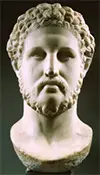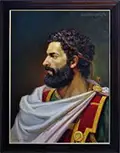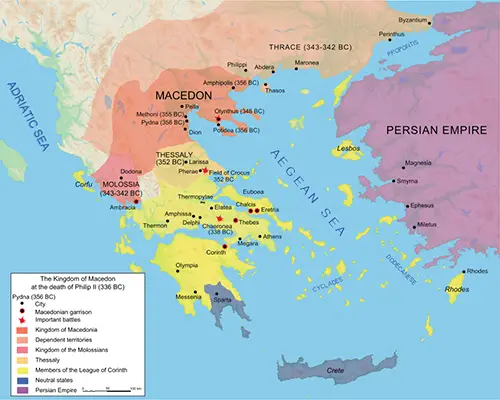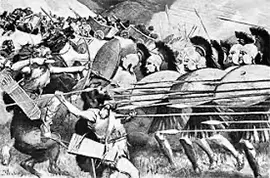King Philip II of Macedon
Philip II was a king of Ancient Macedon and a conqueror of Ancient Greece. The creator of a highly successful army, he is perhaps most well-known as being the father of Alexander the Great. 
Philip was both in 383 B.C. or 382 B.C., the youngest of three sons of King Amyntas III of Macedon and a woman named Eurydice. His father died in 368 B.C., and his brother became King Alexander II. At this time, Philip went to Thebes, officially serving as a royal hostage. During his three-year stay there, he studied military strategy and tactics under the famed commanders Epaminondas and Pelopidas. Alexander II was assassinated in 365 B.C., and his brother Perdiccas took the throne, as King Perdiccas III. This king recalled Philip to serve at his side. In one of the several times that Macedonian armies fought against the Illyrians, Perdiccas III was killed in battle, in 359 B.C., and his young son became King Amyntas IV. Philip was appointed the young king's guardian. Employing what he learned from Epaminondas, Philip reworked the Macedonian army, in particular training them in the use of the sarissa, a 16-foot-long pike, as part of the phalanx, a deadly effective fighting force in which the soldiers appeared to be so many parts of a giant turtle, with each 
In 358 B.C., Macedon reclaimed land recently lost to Paeonia and Illyria. The following year, Philip was officially King Philip II. He violated the terms of a treaty with Athens and attacked Amphipolis, retaking the strategically important city. (Athens and Macedon had agreed to the treaty just a few years earlier, and Macedon had ceded control of that city to Athens as part of the treaty's terms.) Philip then seized the nearby gold mines at Mount Pangaeus and gained much-needed wealth with which finance his by-then professional army. The Macedonians also exacted their revenge on the Thracians, reclaiming lands lost to those neighbors as well. Philip suffered a couple of severe injuries during his various wars. In 354 B.C., while laying siege to the city of Methone, an enemy archer fired an arrow that struck Philip in the right eye, taking away his sight on that side. He responded by taking the city and razing it. Nine years later, fighting against the Adriaioi, he sustained a serious wound in the lower right leg; he walked with a limp for the rest of his life. 
At the same time, Philip was a deft diplomat, shoring up alliances through various turns of monetary compensation and political agreement. He married the Illyrian princess Audata in order to seal an alliance with that land. He married Philinna, a Thessalian noblewoman, to seal a deal with Thessaly; this union produced a son, Philip, who would succeed him as king. To ensure good relations with Arybbas, the King of Epirus, Philip II married Olympias; this union produced Alexander (the great), who ruled for a time as King Alexander III. Another element of Philip's makeover of Macedon was the increase the cultural element of Pella, the capital. He encouraged philosopher, poets, and writers to ply their trade in the capital's corridors. He secured the services of the world-famous Aristotle as a tutor for Alexander. Philip and his troops moved on Greece, picking off the city-states one by one. Publicly, Philip insisted he was building a federation, one he called the Federal League of Corinth. Privately, however, he coveted Greece. One of Philip's main antagonists in Greece was the famed orator Demosthenes, who gave a series of speeches warning of the dangers of Philip's rise. These speeches came to be known as the Philippics. 
This Federal League was announced and put into action in 338 B.C. This followed the major defeat of the Greeks at the Battle of Chaeronea. Of the major city-states, only Sparta was not involved. (In other words, Philip hadn't conquered Sparta yet.) Philip, however, decided to pursue bigger targets: He wanted a piece of the Persian Empire. Philip was a brilliant military commander and politician as well. He juggled the warring sentiments of the Greeks long enough to keep them ready for assimilation, then assembled them all under his banner into what was really a kingdom designed as a federation. He was a great tactician, and his plans for invading the Persian Empire were brilliantly executed#&8211;by his son. Philip was assassinated on the eve of his invasion of Persia; he was 46. Many historical accounts say that the assassin was Pausanias, one of Philip's own bodyguards, and that the assassination took place at or after the wedding feast of Philip's daughter Cleopatra. Philip's son, Alexander, took over the reins of both army and kingdom and put the invasion plans in motion. He was 21. |
|
Social Studies for Kids
copyright 2002–2024
David White



 shield protecting the fighter next to the shield-wielder, who, in turn, was armed with a long pike that extended well behind the shield wall; the unit moved as one and proved incredibly difficult to defeat. The sarissa had a longer reach than anything that Macedon's opponents could match, and this proved a key part of the Macedonians' continued success in the next few decades. Completing the package for the infantry was a set of light body armor and the xiphos, a double-edged sword, for the rare instances when an enemy force penetrated the pike wall of the phalanx. The army also had cavalry, and Philip added siege weaponry to his arsenal. In addition, he increased the overall manpower of the army, boosting the infantry from 10,000 to 24,000 and the cavalry from 600 to 3,500. He gave each soldier a uniform and regular pay, in return for which he exacted an oath of allegiance to him personally. (This was a change, from the normal practice of pledging to protect one's own town of residence.)
shield protecting the fighter next to the shield-wielder, who, in turn, was armed with a long pike that extended well behind the shield wall; the unit moved as one and proved incredibly difficult to defeat. The sarissa had a longer reach than anything that Macedon's opponents could match, and this proved a key part of the Macedonians' continued success in the next few decades. Completing the package for the infantry was a set of light body armor and the xiphos, a double-edged sword, for the rare instances when an enemy force penetrated the pike wall of the phalanx. The army also had cavalry, and Philip added siege weaponry to his arsenal. In addition, he increased the overall manpower of the army, boosting the infantry from 10,000 to 24,000 and the cavalry from 600 to 3,500. He gave each soldier a uniform and regular pay, in return for which he exacted an oath of allegiance to him personally. (This was a change, from the normal practice of pledging to protect one's own town of residence.)
